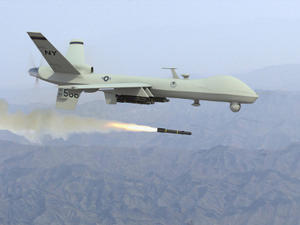In the courtsCIA used inaccurate, hacked code to guide killer UAVs
Two Massachusetts companies — Netezza and IISi — are locked in a legal battle over target acquisition software used by CIA drones to kill terrorists in Pakistan and Afghanistan; IISi charges that Netezza misled the CIA by telling the agency that it could deliver the software — developed by IISi — on Netezza’s new hardware, to a tight deadline; when IISi then refused to rush the job, it is claimed, Netezza illegally and hastily reverse-engineered IISi’s code to deliver a version that produced locations inaccurate by up to 13 meters

UAV launching a hellfire missile // Source: c-x-i.eu
Arthur Miller’s award-winning play, All My Sons, opened on Broadway in January 1947. It is based upon a true story, which Miller’s then mother-in-law pointed out to him in an Ohio newspaper. The story described how a woman informed on her father who had sold faulty parts to the U.S. military during the Second World War.
Seventy years later, the Register’s Chris Williams tells a similar story — this time, about how the CIA knowingly used faulty UAV target-acquisition software. In the true-life story captured by Miller’s play, the victims of the faulty equipment were American soldiers. In the current story, the victims were Afghani and Pakistani civilians.
The CIA is implicated in a court case in which the plaintiffs claim that the agency used an illegal, inaccurate software “hack” to direct secret assassination drones in central Asia.
The target of the court action is Marlborough, Massachusetts-based Netezza, the data warehousing firm that IBM bid $1.7 billion for on Monday. The case raises serious questions about the conduct of Netezza executives, and the conduct of CIA’s clandestine war against senior jihadis in Afghanistan and Pakistan.
Chris Williams writes that the dispute surrounds a location analysis software package — “Geospatial” — developed by a small company called Intelligent Integration Systems (IISi), of Boston, Massachusetts. IISi alleges that Netezza misled the CIA by telling the agency that it could deliver the software — developed by IISi — on Netezza’s new hardware, to a tight deadline.
When IISi then refused to rush the job, it is claimed, Netezza illegally and hastily reverse-engineered IISi’s code to deliver a version that produced locations inaccurate by up to 13 meters. Despite knowing about the miscalculations, the CIA accepted the software, court submissions indicate.
IISi is now seeking an injunction to ban Netezza and the CIA from using the software or any derivative of it, in any context.
The relationship between the two firms dates back to 2006, when IISi signed up to resell Netezza data warehousing kit combined with Geospatial. The code allows users, for example, “to incorporate and cross-reference vast amounts of business data with geographic location within the same database, and enable events (such as… a cell phone signal moving from one tower to another) to be matched with personal characteristics in the database (such as… the identity of the person whose cell phone signal has moved from one tower to another),” according to IISi’s court filings.
Such techniques
